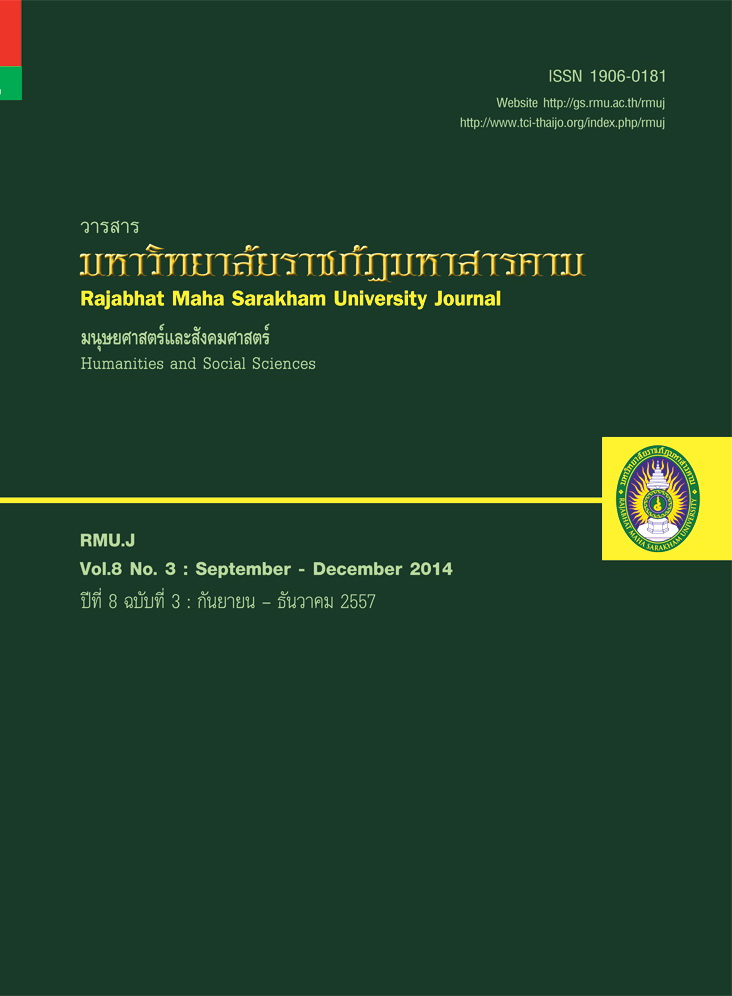การพัฒนาบทเรียนบนเครือข่ายโดยใช้เทคนิคการเรียนรู้แบบร่วมมือรูปแบบแอลที เรื่องพื้นที่ผิวและปริมาตร สำหรับผู้เรียนชั้นมัธยมศึกษาปีที่ 3 Developing Web Based Instruction by Using Learning Together Model (LT) on the Topic of “Surface Area and Capacity” for Gr
Main Article Content
บทคัดย่อ
การวิจัยในครั้งนี้มีวัตถุประสงค์ ประการแรก เพื่อการพัฒนาบทเรียนบนเครือข่ายโดยใช้เทคนิคการเรียนรู้แบบร่วมมือรูปแบบ
แอลที เรื่องพื้นที่ผิวและปริมาตร สำหรับผู้เรียนชั้นมัธยมศึกษาปีที่ 3 ตามเกณฑ์ 80/80 ประการที่สอง เพื่อเปรียบเทียบผลสัมฤทธิ์
ทางการเรียนของกลุ่มทดลองที่ได้รับการจัดกิจกรรมการเรียนรู้ด้วยบทเรียนบนเครือข่ายโดยใช้เทคนิคการเรียนรู้แบบร่วมมือรูปแบบ
แอลทีและกลุ่มควบคุมที่เรียนด้วยวิธีการสอนแบบปกติ ประการที่สามเพื่อหาดัชนีประสิทธิผลของผู้เรียนที่เรียนด้วยบทเรียนบนเครือ
ข่าย และประการที่สี่ศึกษาความพึงพอใจของผู้เรียนชั้นมัธยมศึกษาปีที่ 3 ที่มีต่อการเรียนด้วยบทเรียนบนเครือข่ายที่พัฒนาขึ้นโดยใช้
เทคนิคการเรียนรู้แบบร่วมมือรูปแบบแอลที ผลการวิจัยพบว่า
1. ประสิทธิภาพของบทเรียน (87.91/86.94) ซึ่งสูงกว่าเกณฑ์ที่ตั้งไว้ที่ 80/80
2. ผลการเปรียบเทียบผลสัมฤทธิ์ทางการเรียนของกลุ่มทดลองสูงกว่ากลุ่มควบคุมอย่างมีนัยสำคัญทางสถิติ .05
3. ดัชนีประสิทธิผลของผู้เรียนหลังจากได้เรียนด้วยบทเรียนบนเครือข่ายคิดเป็นร้อยละ 74
4. ความพึงพอใจของผู้เรียนที่มีต่อบทเรียนบนเครือข่ายมีความพึงพอใจอยู่ในระดับมากที่สุด
The objectives of this study were: 1) to develop a web-based instruction program by using the Learning
Together model (LT) on the topic of “Surface Area and Capacity” for 9th grade students
based on the 80/80 standardized criteria, 2) to compare the learning achievement of the experimental
group with the control group, 3) to assess the effectiveness index of the instructional program by using the
Learning Together model, and 4) to survey the satisfaction of the students with the web-based instruction
program. The research results showed that 1) the index of the instructional program efficiency was 87.75/83.75
which were higher than the standardized criteria. 2) The results indicated that the score of the experimental
students was significantly higher than that of the control students at the .05 level. 3) The effectiveness index
of the web-based instruction program by using the Learning Together model was 75 percent. 4) The average level of the satisfaction of the students with the instructional program was very high.
Article Details
1. บทความที่ลงตีพิมพ์ทุกเรื่องได้รับการตรวจทางวิชาการโดยผู้ประเมินอิสระ
2. ข้อคิดเห็นใด ๆ ของบทคามที่ลงตีพิมพ์ในวารสารมหาวิทยาลัยราชภัฏมหาสารคาทม นี้เป็นของผู้เขียน คณะผู้จัดทำวารสารไม่จำเป็นต้องเห็นด้วย
3. กองบรรณาธิการวารสารมหาวิทยาลัยราชภัฏมหาสารคาทม ไม่สงวนสิทธิ์การคัดลอกแต่ให้อ้างอิงแสดงที่มา

